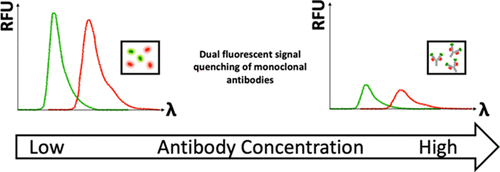当前位置:
X-MOL 学术
›
Anal. Chem.
›
论文详情
Our official English website, www.x-mol.net, welcomes your
feedback! (Note: you will need to create a separate account there.)
Dual-Affinity Ratiometric Quenching (DARQ) Assay for the Quantification of Therapeutic Antibodies in CHO-S Cell Culture Fluids
Analytical Chemistry ( IF 6.7 ) Pub Date : 2020-11-25 , DOI: 10.1021/acs.analchem.0c04269 Brendan L. Turner 1 , Katie M. Kilgour 2 , Sydney J. Stine 2 , Michael Daniele 1, 3 , Stefano Menegatti 2, 4
Analytical Chemistry ( IF 6.7 ) Pub Date : 2020-11-25 , DOI: 10.1021/acs.analchem.0c04269 Brendan L. Turner 1 , Katie M. Kilgour 2 , Sydney J. Stine 2 , Michael Daniele 1, 3 , Stefano Menegatti 2, 4
Affiliation

|
More than 100 monoclonal antibodies (mAbs) are in industrial and clinical development to treat myriad diseases. Accurate quantification of mAbs in complex media, derived from industrial and patient samples, is vital to determine production efficiency or pharmacokinetic properties. To date, mAb quantification requires time and labor-intensive assays. Herein, we report a novel dual-affinity ratiometric quenching (DARQ) assay, which combines selective biorecognition and quenching of fluorescence signals for rapid and sensitive quantification of therapeutic monoclonal antibodies (mAbs). The reported assay relies on the affinity complexation of the target mAb by the corresponding antigens and Protein L (PrL, which targets the Fab region of the antibody), respectively, labeled with fluorescein and rhodamine. Within the affinity complex, the mAb acts as a scaffold framing the labeled affinity tags (PrL and antigen) in a molecular proximity that results in ratiometric quenching of their fluorescence emission. Notably, the decrease in fluorescence emission intensity is linearly dependent upon mAb concentration in solution. Control experiments conducted with one affinity tag only, two tags labeled with equal fluorophores, or two tags labeled with fluorophores of discrete absorbance and emission bands exhibited significantly reduced effect. The assay was evaluated in noncompetitive (pure mAb) and competitive conditions (mAb in a Chinese Hamster Ovary (CHO) cell culture harvest). The “DARQ” assay is highly reproducible (coefficient of variation ∼0.8–0.7%) and rapid (5 min), and its sensitivity (∼0.2–0.5 ng·mL–1), limit of detection (75–119 ng·mL–1), and dynamic range (300–1600 ng·mL–1) are independent of the presence of CHO host cell proteins.
更新日期:2020-12-15











































 京公网安备 11010802027423号
京公网安备 11010802027423号